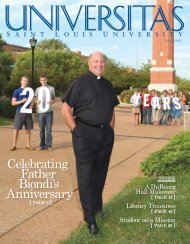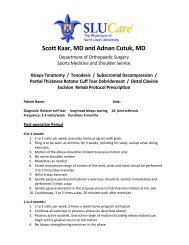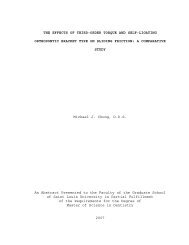Program Manual - Saint Louis University
Program Manual - Saint Louis University
Program Manual - Saint Louis University
You also want an ePaper? Increase the reach of your titles
YUMPU automatically turns print PDFs into web optimized ePapers that Google loves.
4. Attach saliva ejector tip, sterilized hand piece and sterilized/disinfected three-way<br />
syringe when appropriate for the treatment procedure.<br />
5. Place a toothbrush and a cup of mouth-rinse where they will be accessible to the<br />
patient.<br />
6. Set up all items to be used during the delivery of care.<br />
Patient Treatment Protocol<br />
1. General<br />
a. Instruct the patient to brush their teeth and then rinse with mouthwash for<br />
one minute.<br />
b. Wash hands and wrists at the unit and glove. Once gloved, touch only the<br />
patient and barrier-covered areas or areas that have been cleaned and<br />
disinfected.<br />
2. Charting<br />
Do not touch the record with contaminated gloves. If an entry has to be<br />
made in the record during treatment, an appropriate barrier must be used on<br />
the pen and over the portion of the record that the contaminated glove will<br />
touch. As an alternate, delay making chart entries until the end of treatment.<br />
Another alternative is to us a sterile pencil and note paper, then recopy later.<br />
3. High-speed Evacuation System<br />
When applicable, a high-speed evacuation system should be used and all<br />
possible precautions should be taken when using the high-speed hand piece,<br />
water spray or ultrasonic scaler or during a procedure that could cause<br />
spatter.<br />
4. Three-way syringe<br />
The three-way syringe is hazardous because it produces spatter. Therefore,<br />
caution must be used when spraying teeth and the oral cavity. When used, a<br />
potential for spatter must always be considered and appropriate precautions<br />
taken (for example, use of barrier protection). The use of non-spatter producing<br />
methods of cleansing, such as the use of warm, moist cotton pellets or use of<br />
water before air, is recommended.<br />
5. Dropped instruments<br />
An instrument, arch wire, etc. that is dropped will not be picked up and reused.<br />
If the item is essential for the procedure, a sterilized replacement must be used,<br />
or, in the case of customized arch wires, the wire must be sterilized prior to<br />
replacement in the patient.<br />
6. Disposable items<br />
Used disposable items should be discarded immediately to avoid contamination<br />
of other items. Contaminated waste must be placed in the Biohazard labeled<br />
waste container. All other waste should be placed in the standard waste<br />
container.<br />
11

















